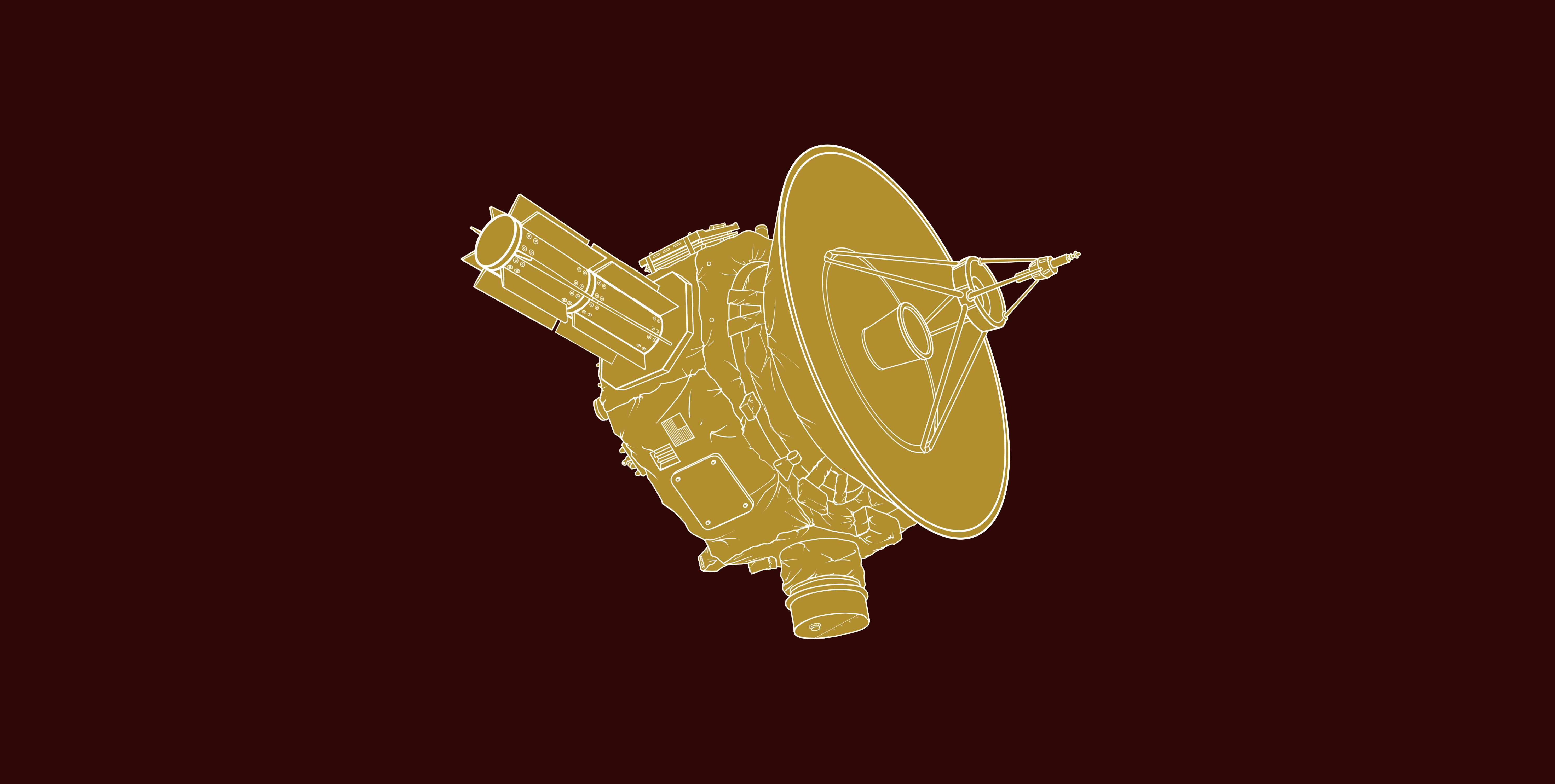 |
| Artist’s illustration of the New Horizons spacecraft. Credit: Sebastian Kings |
It
is exactly one year since New Horizons hurtled through the Pluto system
at 49,600 km/h, after a journey of nearly nine and a half years, its
array of scientific instruments gathering precious data on this hitherto
mysterious world and its family of moons. We shared in the thrill of
the flyby and then watched in awe as a new world was finally revealed in
all its beauty and complex detail. The final approach of the probe, its
flyby, the first images and data were featured in RocketSTEM last
summer.
Since its historic encounter, the 400kg spacecraft, the first to
explore the dwarf planet, has been slowly transmitting back to Earth the
wealth of data collected last summer and stored in its onboard
computers. As of July 2016 about three-quarters of the 50-plus gigabits
of data collected have been downloaded. This has enabled the science
team to build up a comprehensive portrait of the dwarf planet, its five
moons and their environment in space.
What was little more than a point of light for much of the 85 years
since its discovery by Clyde Tombaugh in 1930, is now revealed in detail
as a real world. The results so far are spectacular and surprising. In
the words of Dr. Leslie Young, New Horizons’ Deputy Project Scientist,
‘Pluto did not disappoint. It was the star and we were the paparazzi!’
This article provides an overview, one year on, of the discoveries
made so far from its brief encounter, as well as some of Dr. Young’s
reflections on the mission and her role in planning the encounter.
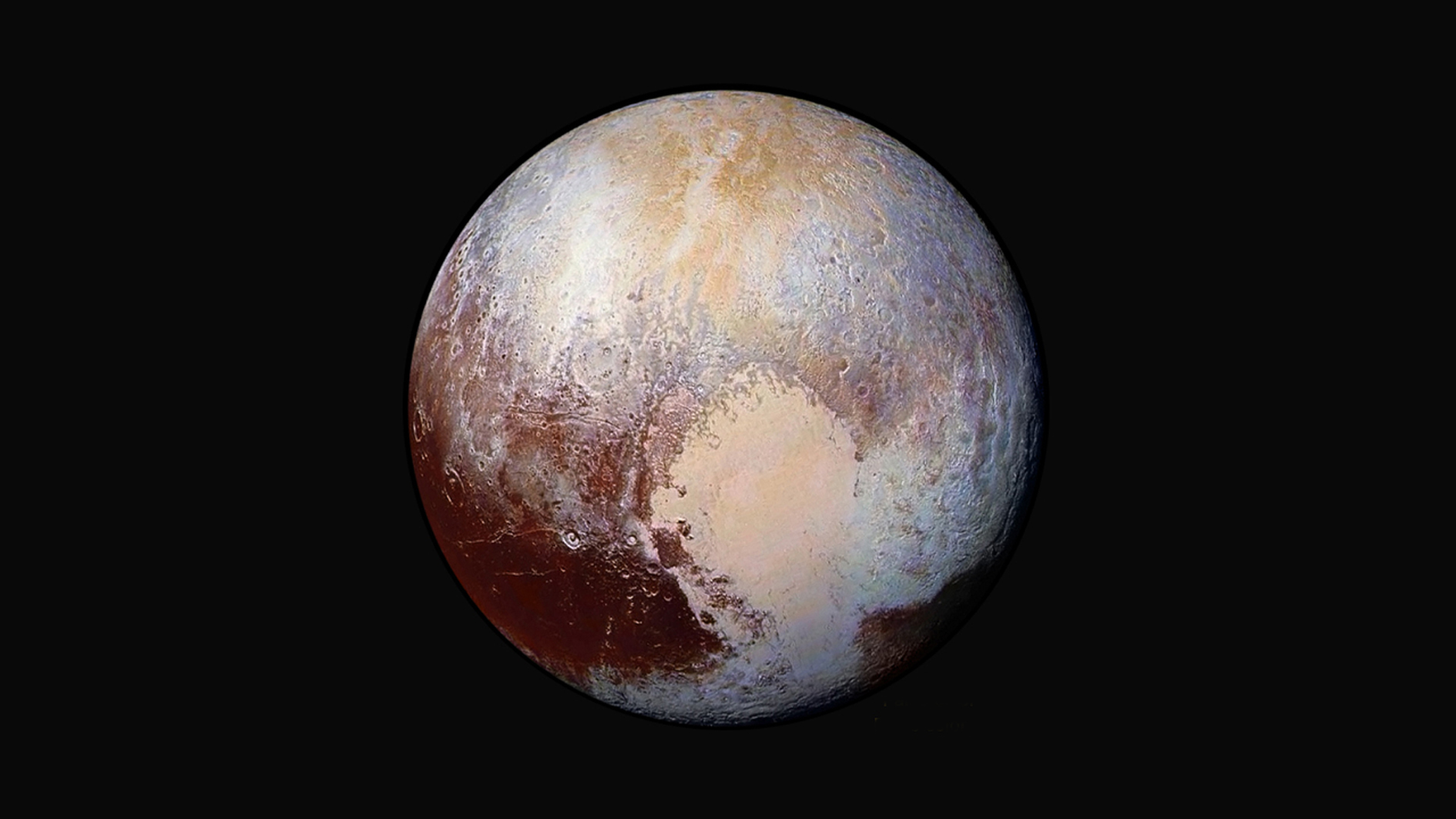 |
| Figure 1: Iconic image – the enhanced-colour portrait of Pluto taken by New Horizons’ Long Range Reconnaissance Imager (LORRI) from a distance of 450,000 km (280,000 miles). Centred on the ‘heart’ of Tombaugh Regio, it shows features as small as 2.2 km (1.4 miles). Four images were combined with colour data from the Ralph instrument to create this view. Credit: NASA/JHUAPL/SwRI |
Eyes wide open
At a mean distance from the Sun of 5.9 billion kilometres, some 39.5
times further away than the Earth, where mean temperatures are only 33K
(minus 240°C), one might expect these worlds to be inert and frozen,
cratered relics bearing mainly the scars of the violent early days of
solar system formation. However, previous missions, from Voyager to
Cassini, have taught us that the outer solar system is far more exotic
and active than we would ever have imagined. In particular, Voyager 2’s
1989 flyby of Triton, Neptune’s largest satellite, with its interesting
chemistry, atmosphere and nitrogen ‘geysers’, hinted at exciting things
to come from New Horizons. This was especially so as Triton was thought
possibly to be a near ‘twin’ of Pluto.
Accordingly, New Horizons was equipped with a suite of sophisticated
scientific instruments, so as to have its eyes (and other senses) as
wide open as possible for the encounter. Previous missions helped inform
the choice and design of data-collecting instruments. For instance, as
Dr. Young points out, ‘One of the things we learned from flying Voyager
at Triton was that, boy, if you want to learn what things are made of
you really need the infrared!’ So, as well as a telescopic, high
resolution camera (LORRI), the spacecraft’s ‘Ralph’ instrument was both a
visible and infra-red wavelength imager and spectrometer, while the
‘Alice’ detector operated in the ultraviolet. At such great distances
from the Sun, the instruments were designed to function in the cold
conditions and low light levels at Pluto and in the Kuiper Belt beyond.
 |
| Credit: NASA/JHUAPL/SwRI |
Asking the right questions – New Horizons’ science payload
The New Horizons science payload consists of seven instruments –
three optical instruments, two plasma instruments, a dust sensor and a
radio science receiver and radiometer. It was designed to investigate
the global geology, surface composition and temperature of Pluto and its
moons, as well as the dwarf planet’s atmospheric characteristics –
pressure, temperature, structure, escape rate -, and interactions with
the solar wind and space environment.
Needing to operate so far from the Sun, the whole payload is powered by a radioisotope thermoelectric generator (RTG), running on a total of less than 28 watts. In order to include a maximum of science, but with as little payload weight as possible, ‘it represents’ to quote the New Horizons team, ‘a degree of miniaturization unprecedented in planetary exploration.’
• Long Range Reconnaissance Imager (LORRI) – telescopic camera to obtain high resolution geological data
• Ralph – a visible and infrared imager/spectrometer for colour, compositional and thermal mapping.
• Alice – an ultra-violet imager/spectrometer to analyse the structure and composition of Pluto’s atmosphere, as well as searching for atmospheres around Charon and other KBOs.
• Radio Science Experiment (REX) – radiometer to measure composition and temperature of Pluto’s atmosphere
• Pluto Energetic Particle Spectrometer Science Investigation (PEPSSI) – energetic particle spectrometer to measure the composition and density of ions escaping from Pluto’s atmosphere
• Solar Wind Around Pluto (SWAP) – solar wind and plasma spectrometer to measure Pluto’s interaction with the solar wind and the escape-rate of its atmosphere
• Venetia Burney Student Dust Counter (SDC) – a student experiment to measure space dust impacts during New Horizons voyage. Named after the person who, as a child, suggested the name Pluto after its discovery by Clyde Tombaugh in 1930.
Needing to operate so far from the Sun, the whole payload is powered by a radioisotope thermoelectric generator (RTG), running on a total of less than 28 watts. In order to include a maximum of science, but with as little payload weight as possible, ‘it represents’ to quote the New Horizons team, ‘a degree of miniaturization unprecedented in planetary exploration.’
• Long Range Reconnaissance Imager (LORRI) – telescopic camera to obtain high resolution geological data
• Ralph – a visible and infrared imager/spectrometer for colour, compositional and thermal mapping.
• Alice – an ultra-violet imager/spectrometer to analyse the structure and composition of Pluto’s atmosphere, as well as searching for atmospheres around Charon and other KBOs.
• Radio Science Experiment (REX) – radiometer to measure composition and temperature of Pluto’s atmosphere
• Pluto Energetic Particle Spectrometer Science Investigation (PEPSSI) – energetic particle spectrometer to measure the composition and density of ions escaping from Pluto’s atmosphere
• Solar Wind Around Pluto (SWAP) – solar wind and plasma spectrometer to measure Pluto’s interaction with the solar wind and the escape-rate of its atmosphere
• Venetia Burney Student Dust Counter (SDC) – a student experiment to measure space dust impacts during New Horizons voyage. Named after the person who, as a child, suggested the name Pluto after its discovery by Clyde Tombaugh in 1930.
Pluto encounter planning
Dr. Young, who is based at the Southwest Research Institute in
Boulder, Colorado, describes some key considerations when planning for
New Horizons’ Pluto encounter and beyond. Describing herself as a
‘Pluto person, rather than a spacecraft person’ and ‘pretty well-rounded
when it comes to all aspects of Pluto science’, she was also heavily
involved in planning the mission as the Pluto Encounter Planning Team
Leader.
Invited by Principal Investigator Dr. Alan Stern at the mission
proposal stage to plot the quality of the data needed, which required
her to plan for how the data was to be collected and how well the
different instruments might work, she says she ‘was in a good position
to be his right hand.’ She says that her early work on stellar
occultation on Professor James Elliot’s team at MIT, a field involving
meticulous advance planning, and which led to her passion for Pluto,
also stood her in good stead. ‘It was the discovery that Pluto had an
atmosphere while I was working with Jim Elliot in 1988 that changed my
life!’
 |
| Figure 3: Pluto and its family of moons – Selected statistics. Credit: NASA |
Obviously, Pluto’s atmosphere was a key target for New Horizons, as
was its interaction with the solar wind and the complex relationship
with Pluto’s surface, especially regarding the behaviour of volatiles
like nitrogen and methane. And then, of course, there was Pluto’s large
moon, Charon, discovered by United States Naval Observatory astronomer
James Christy in 1978. At just over half Pluto’s size and about
one-eighth its mass (see Fig. 3 for statistics on Pluto and its moons),
Charon is large enough to be considered as part of a binary system with
Pluto, especially as the two orbit a barycentre (common centre of
gravity) outside Pluto itself. Figure 2 shows the sizes of Pluto in
Charon compared to that of the USA. Charon’s contrasting brightness with
that of Pluto and Earth-based observations of its surface chemistry had
indicated that it could be an equally intriguing world.
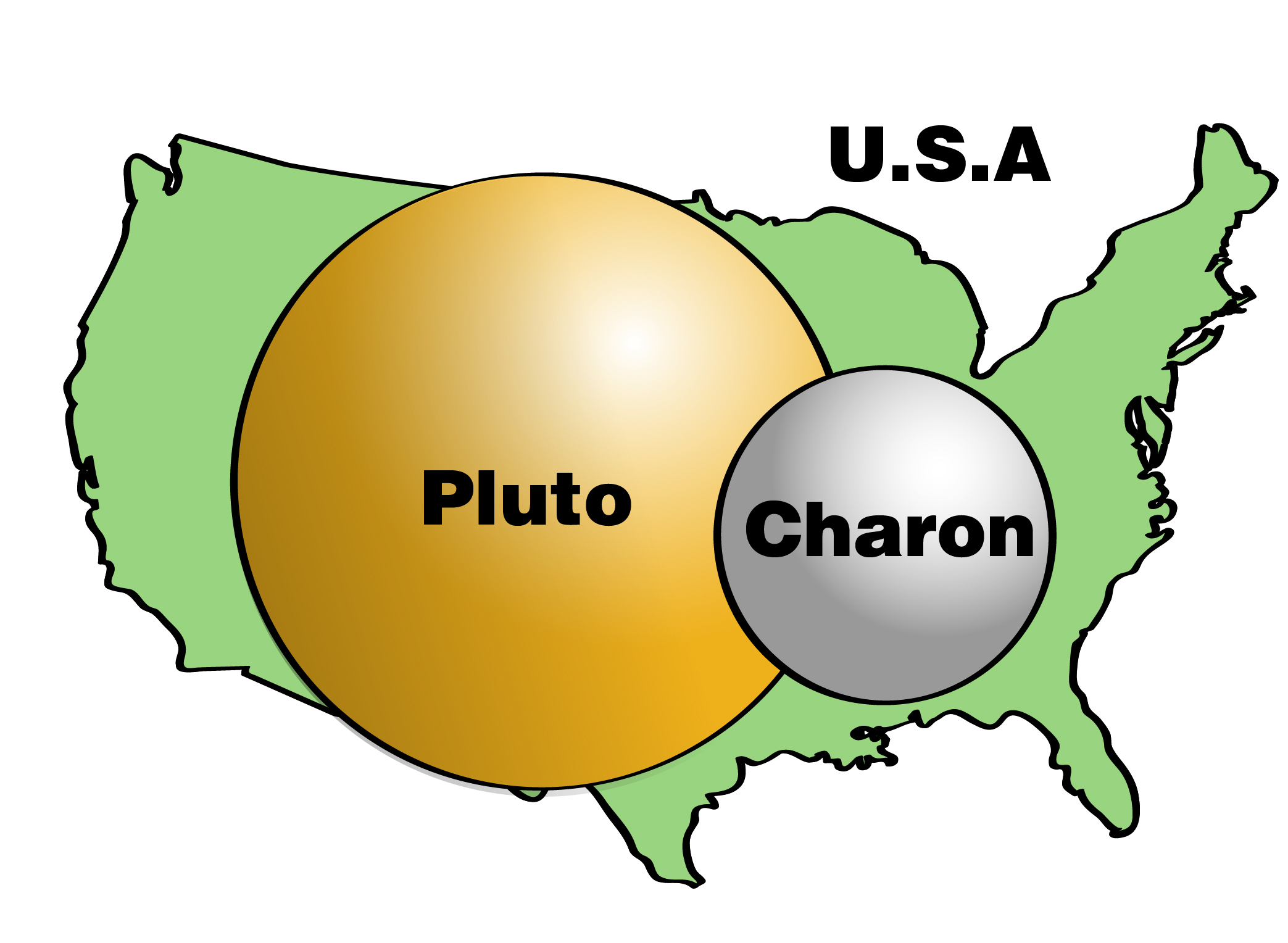 |
| Figure 2: Size of Pluto and Charon compared with America. Credit: NASA |
Earth-based observations of Pluto’s mysterious, mottled surface, barely resolved by the Hubble Space Telescope, also informed the choice of hemisphere for the encounter. Figure 4 shows (a) the best low-resolution mapping of Pluto from Earth compared to (b) the global map of Pluto based on imaging by the New Horizons spacecraft.
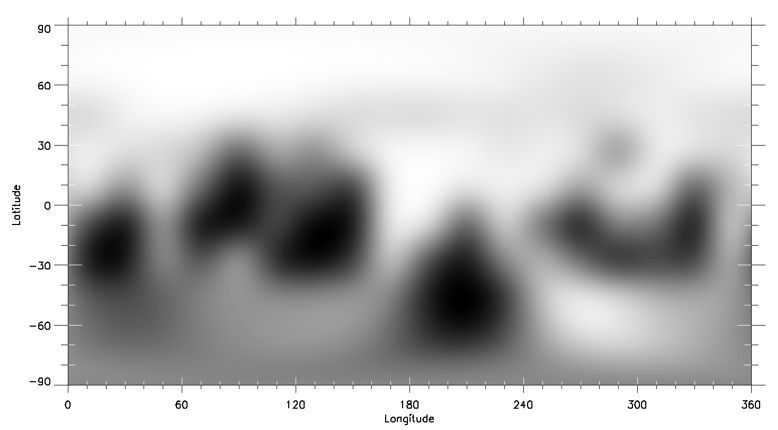 |
| Figure 4 (a): An example of the best pre-flyby maps of Pluto, made from images from the Hubble Space Telescope in 2002 and 2003, showing contrasts in albedo. The target hemisphere was that centred on the equator and a longitude of 180°, the location of the bright feature named Sputnik Planum after encounter. Credit: NASA/JHUAPL/SwRI/Marc Buie |
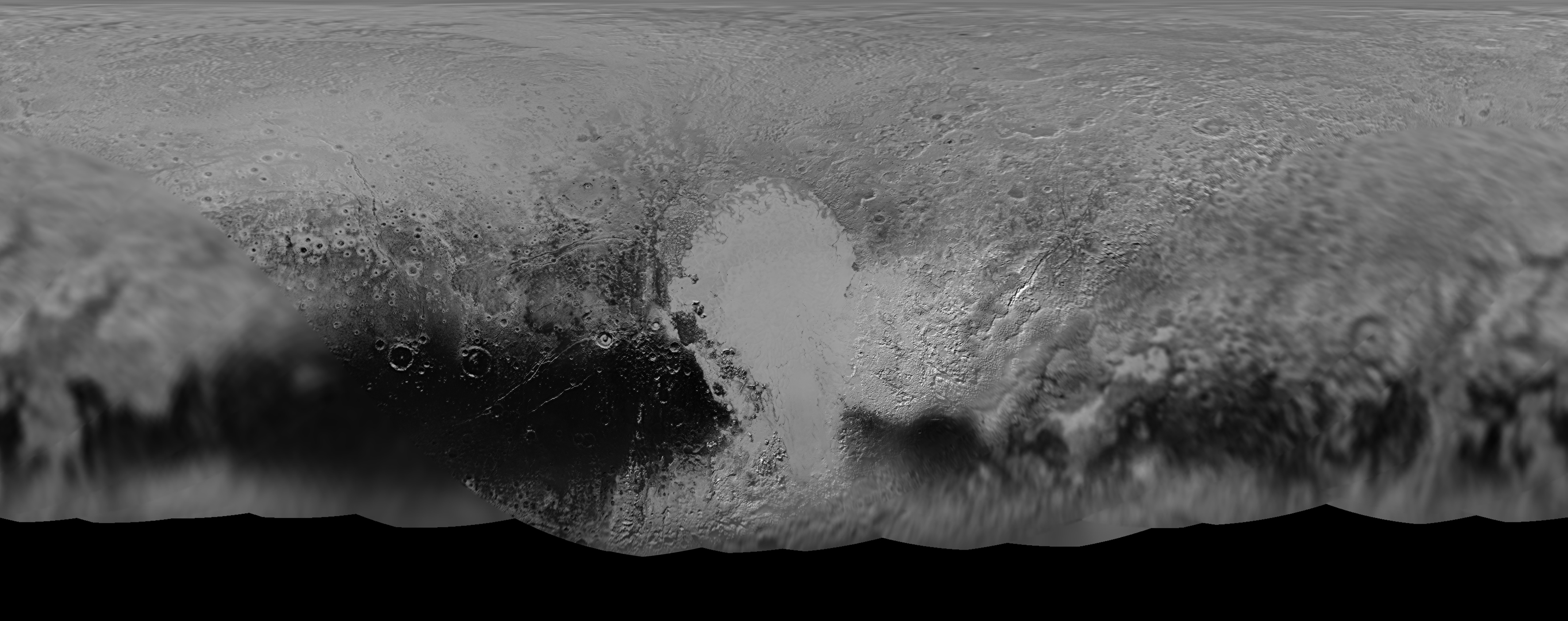 |
| Fig 4 (b): Panchromatic composite global map of Pluto created from images taken at varying distances, and hence, at different resolutions. Sputnik Planum is clearly visible. The dark features along the equatorial region are also clearly resolved. Note that much of the southern hemisphere, currently tilted away from the Sun, is not shown in this map. Credit: NASA/JHUAPL/SwRI |
Says Leslie Young, ‘We knew from early low resolution mapping from
the Earth, before we even considered the mission, that Pluto is one of
the most contrasty bodies in the solar system. We knew that where you
have rapid transitions from very dark to very bright, there’s going to
be something interesting going on. That’s what determined our choice of
which side to image at closest approach. I think the findings show that
we made the right choice!’
Early surprises – working round Pluto’s new moons
New Horizons had a chance to try out its science instruments during
its flyby of Jupiter in early 2007, studying the giant planet’s
atmosphere, magnetosphere, moons and ring system. Even during the long
cruise phase of the mission beyond Jupiter, when the spacecraft spent
much time in hibernation mode, there was much to keep the New Horizons
team occupied. In particular, Leslie Young describes what happened when
new moons were discovered orbiting Pluto after the mission had launched
in January 2006 (see Fig. 5).
‘We got a surprise when we discovered Kerberos and Styx! We’d
discovered Nix and Hydra in 2005, which was exciting, two extra targets
and we were able to configure in our arrival time and our observing
sequence to do a good job on them. When we discovered Kerberos (June
2011) and Styx (June 2012), we thought ‘Oh my God! How much else is out
there?’ We weren’t so much worried about hitting a moon, the odds are
really small, but if you get a moon and meteorites hitting it, they’ll
knock off dust which will hang around in the system because the moons
don’t have enough gravity to hold onto it. If you hit something the size
of a chick-pea, it could be a bad day for New Horizons! So we had that
period of about two years of unscheduled and nerve-wracking work, taking
simulations with pieces of the spacecraft to fancy gun-ranges and
coming up with entire new trajectories – what we called SHBOTs (Safe
Haven by Other Trajectories) – and whole new observing plans to make
things less vulnerable.
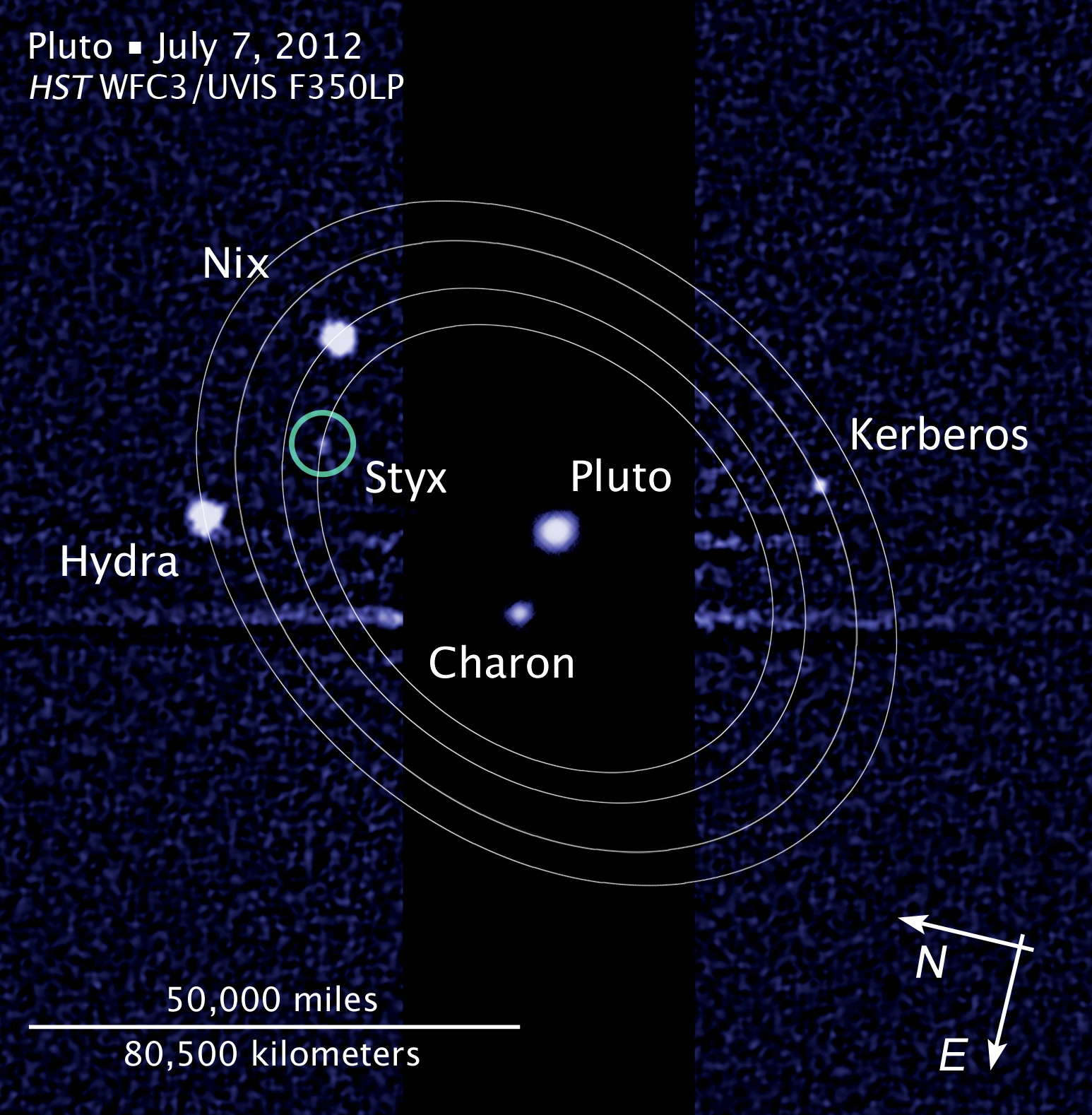 |
| Figure 5: Discovery image of Pluto’s tiny moon Styx in 2012, overlaid with orbits of the satellite system, which gave cause for concern to the Pluto Encounter Planning (PEP) Team. Credit: NASA/ESA/L. Frattare (STScI) |
In case of problems, there were two tricks we could use. One was to
skim the top of Pluto’s atmosphere where it would cut down on some of
the dust through atmospheric drag. And the other was to turn New
Horizons itself so that the antenna would shield the rest of the
spacecraft.
Another thing we did was to practise running the whole encounter
through, having somebody invent data from the satellite. We ran the
simulation three times, as it would be by the clock, with data coming
down, people detecting moons, calculating orbits, calculating how much
stuff there would be and how risky that might be. We simulated making
recommendations, with NASA officials there to run through the procedure.
In the end, all of that was very useful because it turned out that to
get anything risky we had to have a thousand satellites hiding in
between Pluto and Charon to even make us consider trajectory changes.
And it helped us make sure we got the best data in the end. Everybody
was very happy with the final decision. Everybody was holding their
breath a bit on encounter day, but it all went perfectly.’
Complex and dynamic world
So what have the New Horizons’ team learned so far from the
encounter? It is beyond the scope of this article to describe all the
discoveries made by the spacecraft, so we focus here on some of the most
significant ones. (A list of recommended further reading is suggested
at the end)
Planetary mission scientists have learned to expect the unexpected,
and Pluto has certainly provided many surprises. One of the biggest has
been its ‘astonishing variety of landscapes’, from the 1000km-wide
uncratered plain of Sputnik Planum, bounded by mountainous regions, such
as Al-Idrisi Montes and Hillary Montes, to cratered plains mantled with
either brighter ices (north polar region) or darker deposits (Cthulhu
Regio and Krun Macula), and rugged uplands marked with pits or
elongated, raised ‘blades’ on the eastern section of Tombaugh Regio.
This diversity provides evidence of a long and complex geological
history, with some of it unexpectedly recent.
These features can be identified on the composite global map (Figure
6), created from images taken during approach and flyby, which shows the
main regions, together with their provisional names (these have yet to
receive formal approval by the International Astronomical Union).
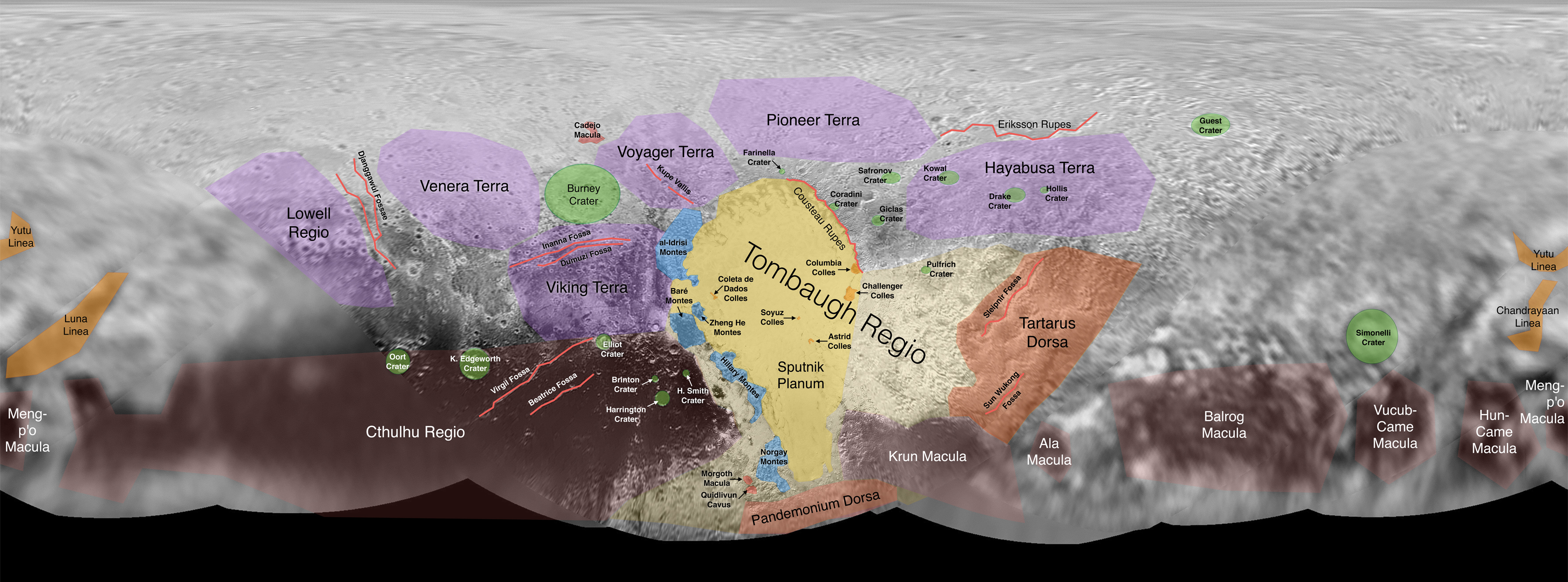 |
| Figure 6: Informal names for regions on Pluto, based on a public naming campaign endorsed by the IAU, in partnership with NASA’s New Horizons mission and the SETI Institute. Credit: NASA/JHUAPL/SwRI/SETI Institute |
To understand Pluto’s surface, we must remember that, at a distance
of 30 to 50 times Earth’s distance from the sun, Pluto is one of the
coldest large bodies in the solar system with surface temperatures
ranging from about only 33K (-240°C) to 55K (-218°C). Its surface
composition and chemistry are quite different from those on Earth,
although they do operate in a way to bring about analogous geological
processes. So, rather than the Earth’s rocky mountains floating on a
mantle of magma, we find what Leslie Young describes as ‘platoons of
water-ice mountains floating in seas of frozen nitrogen – water is like
the bedrock here.’ It is the nitrogen, also the dominant component of
Pluto’s atmosphere, which appears to be involved in the most surprising
surface processes observed – active glacial flow and the resurfacing of
Sputnik Planum. This plain is located in what is probably an ancient
impact basin, given the arcuate nature of the mountains bordering it on
three sides.
Figure 7 shows the north-west edge of Sputnik Planum, where it meets
Al-Idrisi Montes. There are flow patterns towards the mountains at the
margin. There is also clear evidence of glacial flow channels in the
oblique angle view of Sputnik Planum shown in Figure 8. At the surface
nitrogen ice, which is structurally-weak compared to the rock-hard water
ice, has a low enough viscosity to flow at the temperatures found on
Pluto’s surface. This surface flow is analagous to that of glaciers on
Earth, with the volatiles flowing ‘more slowly than silly putty but ….
faster than glacial water ice on Earth.’
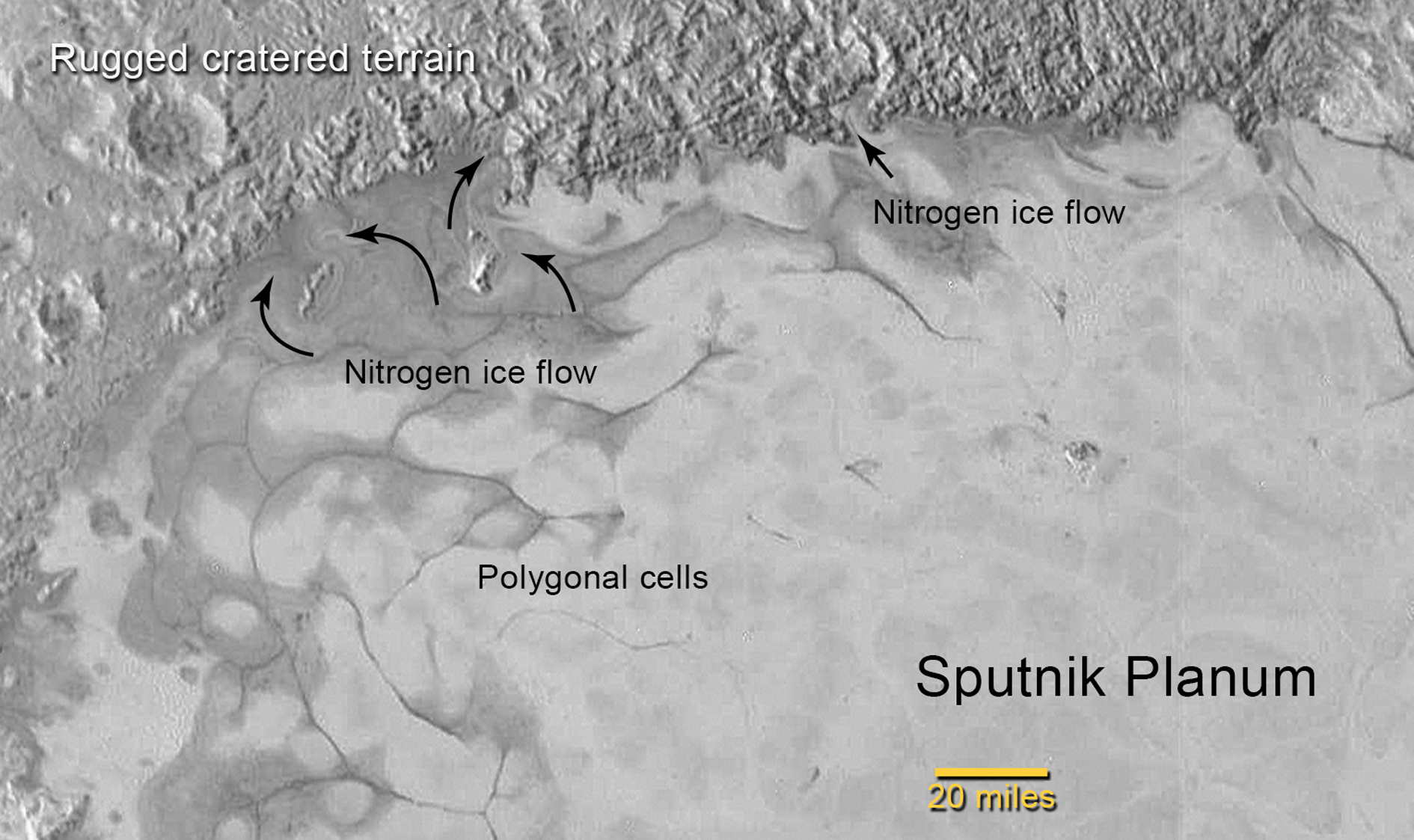 |
| Figure 7: Polygonal cells and glacial flow on the northern margins of Sputnik Planum. Credit: NASA/JHUAPL/SwRI |
The surface of the plain appears relatively young, being uncratered,
and is broken into a network of polygonal cells, 10 to 40km across, with
their centres rising some tens of metres above their margins, the
latter characterised by darker X- and Y-shaped junctions. Modelling
would indicate that this giant basin is probably filled with a 5 to 10
km-thick layer of frozen volatiles: nitrogen, methane, and carbon
monoxide ices, but dominated by nitrogen ice. Within this layer
solid-state convection may be occurring, with rising plumes of ice
creating the surface polygons, at the edges of which the cooled material
sinks back down. This can be likened to what happens in a pan of soup
being gently heated from below, or a ‘cosmic lava lamp.’ The overturn
rate is estimated at 1.5-3cm per year, which would put renewal times of
Spunik Planum’s surface at 500,000 to 1 million years, very young by
geological standards. This would explain the absence of craters on its
surface.
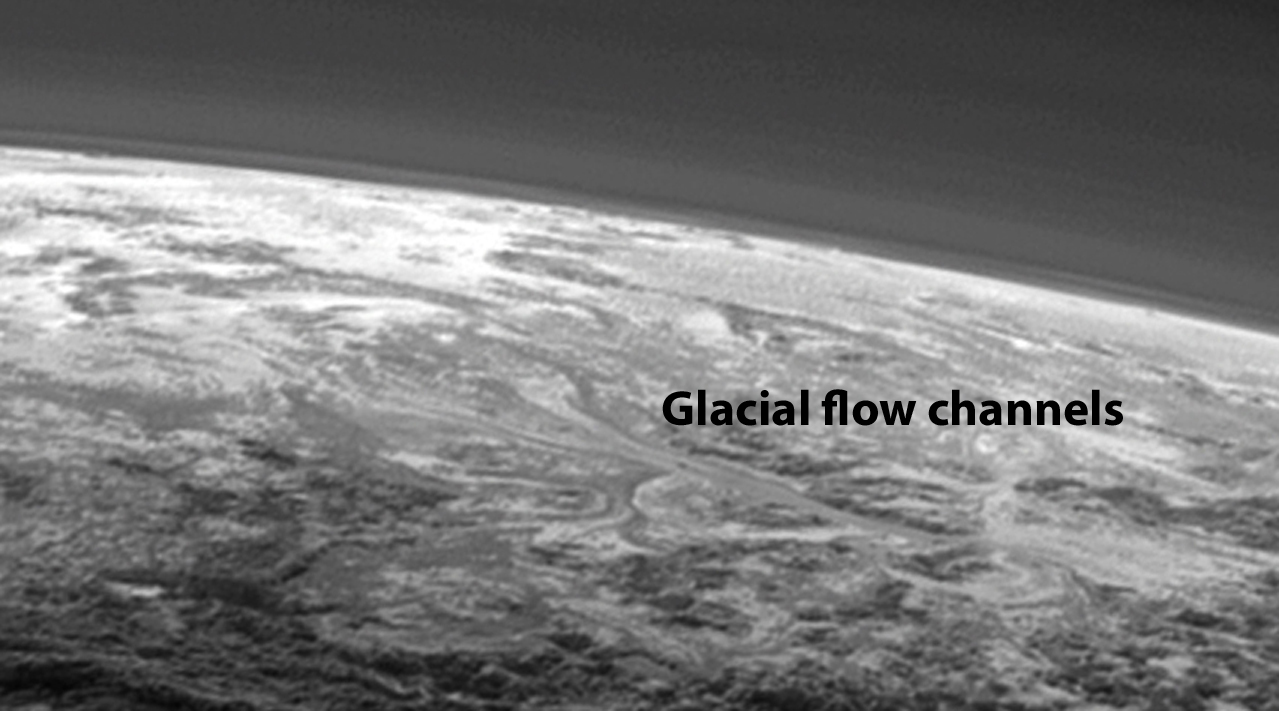 |
| Figure 8: Evidence of glacial flow channels is seen in this oblique view of Sputnik Planum. Credit: NASA/JHUAPL/SwRI |
The big questions posed by these discoveries are how such activity is
driven on Pluto and what internal heat source(s) could create
convection in this way? The accretional heat from the formation of Pluto
would long since have been lost to space, as would any residual heat
from early impacts, such as the one believed to have created the
Pluto-Charon system. And there is no nearby large body to create tidal
heating within Pluto, as is the case for example, for Jupiter’s moons Io
and Europa.
This leaves radiogenic heating – heat released slowly by the decay of
radioactive isotopes within the dwarf planet. While an isotope such as 26Al,
with a short half-life of only 730,000 years, would have been depleted
rapidly in the early days of the solar system, one possible candidate
among others would be the isotope of potassium, 40K, with a
half-life of 1.3 billion years (the biggest contributor today to the
Earth’s radiogenic heat source). Potassium is also possibly more common
within Pluto’s rocky core (see Figure 9) than it is in Earth, as it is
relatively volatile and would have boiled away more rapidly from the
solar nebula in the early Earth’s neighbourhood. And even if the heat
source is relatively weak today, with an estimated radiogenic heat flux
of roughly 3 mW per square metre as compared to about 80 mW m-2 for the
Earth, it’s thought that nitrogen ice, being a good thermal insulator,
could store sufficient heat at depth to initiate convection.
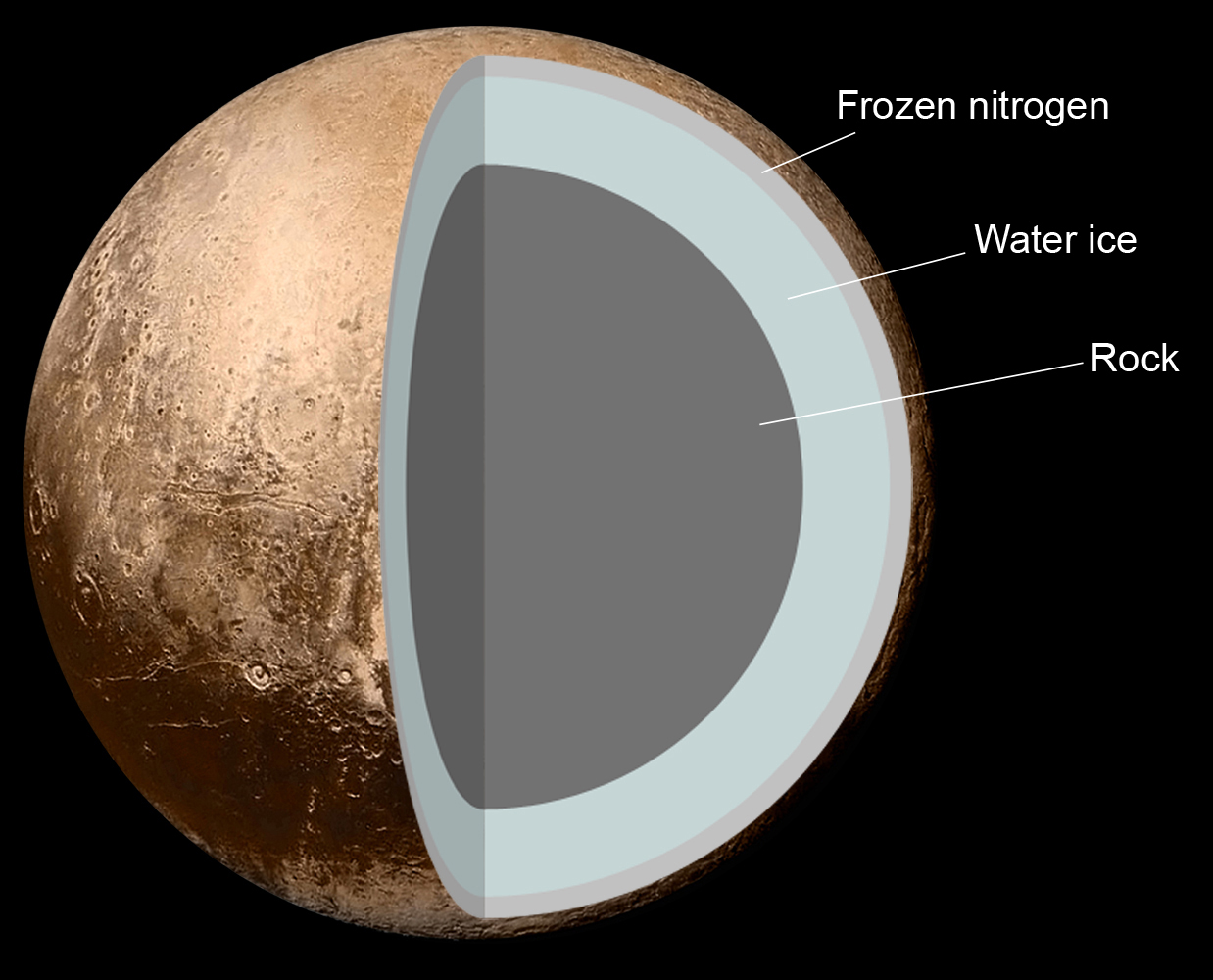 |
| Figure 9: Pluto’s density is 1.860g/cm3. This would imply a mixture of rock and ices. The rocky core contains radioactive isotopes which decay over time, producing a weak internal heat source. There is some speculation that faulting of Pluto’s surface, which is indicative of past expansion of the dwarf planet, may be evidence for a residual subsurface liquid water layer some 100 to 180 km thick at the core–mantle boundary, like the sub-surface oceans postulated for Europa, Ganymede or Titan. Credit: NASA/JHUAPL/SwRI |
Pits, blades, haloes and gunk
Pluto’s atmosphere may well be replenished by this convective
activity. Elsewhere, ‘much of what we see … can be attributed to
surface-atmosphere interactions and the mobilization of volatile ices by
insolation.’ These have, for instance, produced striking landforms on
Sputnik Planum and Tombaugh Regio. At such low surface atmospheric
pressures as on Pluto (about 10µbar – microbars – 100,000 less than
Earth’s, the equivalent of being at an altitude of 80 km on Earth)
transfer of volatiles from the surface (ice) to the atmosphere (gas)
currently takes place directly by sublimation. This leaves the terrain
pitted with holes a few hundred meters wide by a few tens of meters
deep. In some areas these are aligned (Figure 10), but the reason for
this is not yet clear.
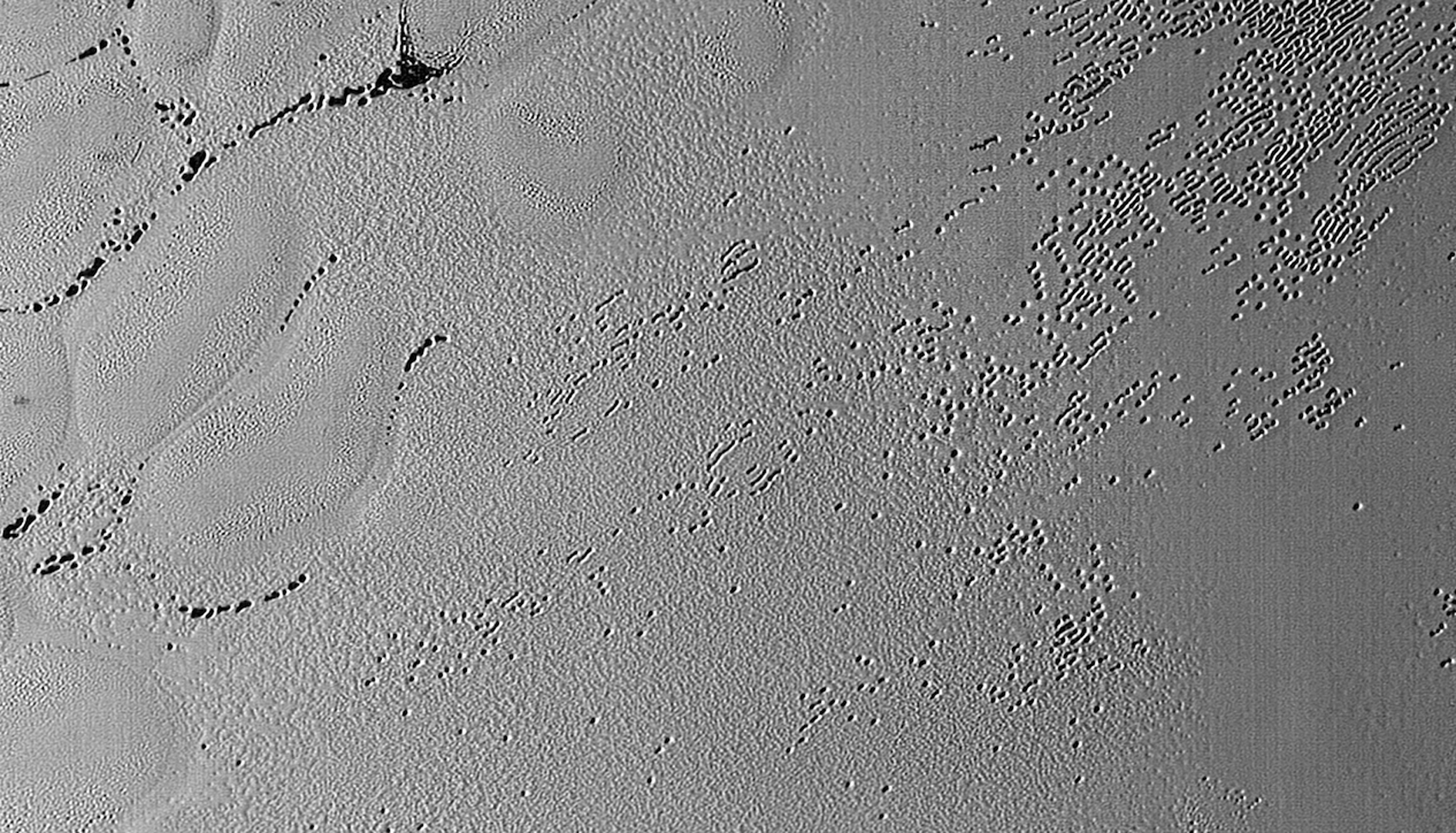 |
| Figure 10: Pitted terrain on Sputnik Planum. Credit: NASA/JHUAPL/SwRI |
Interactions with the atmosphere may also explain the bizarre,
so-called ‘bladed’ terrain in Tartarus Dorsa, east of Tombaugh region
(Figure 11), described as ‘texturally ‘snakeskin’-like, owing to their
….scaly raised relief.’ Typically a few hundred metres high and spaced a
few kilometres apart, these long, steep, tightly-packed ridges align
from north to south. Current theories to explain them include erosion
from evaporating ices, deposition of methane ices, or even structures
formed from primitive methane clathrates, with origins dating back to
the proto-solar nebula.
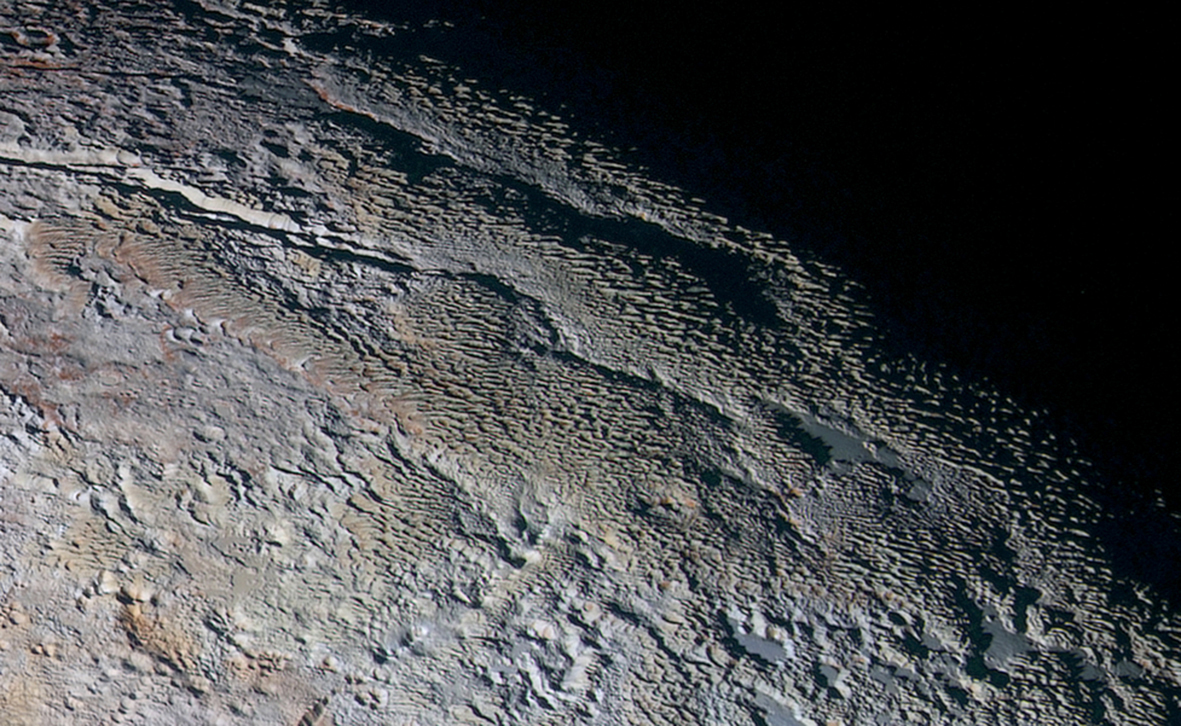 |
| Figure 11: Bladed terrain in Tartarus Dorsa. Credit: NASA/JHUAPL/SwRI |
Elsewhere, large bright regions are seen where frozen volatiles from
the atmosphere have been deposited, especially across more heavily
cratered higher latitudes. In one region strange ‘halo’ craters were
observed, the haloes apparently created by methane ices deposited on the
crater rims, whereas the darker crater floors and intermediate terrain
show signs of being dominated by water ice. Possible reasons for this
distribution of ices, shown in Figure 12, are yet to be determined.
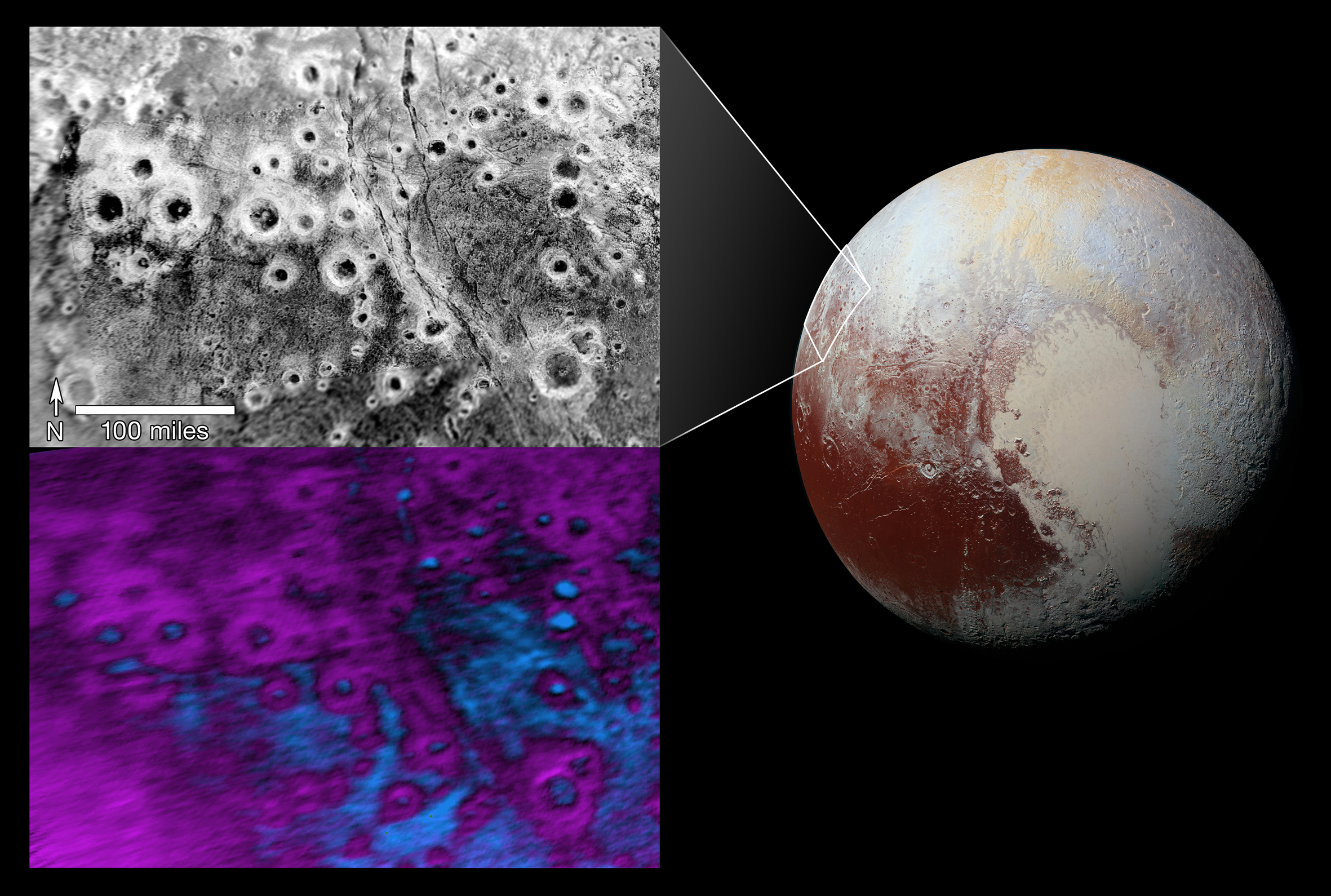 |
| Figure 12: Halo Craters and methane distribution on Pluto. In the upper image, shown in visible light, the craters’ bright rims stand out sharply from their dark floors and the surrounding terrain. In the lower image, created from composition data gathered by the Ralph/Linear Etalon Imaging Spectral Array (LEISA), there seems to be a correlation between the bright halos and distribution of methane ice, shown in false colour as purple. The floors and terrain between coloured blue, show evidence of water ice. The largest crater here is 50 km across. Credit: NASA/JHUAPL/SwRI |
Not all of Pluto’s surface materials are ices. Deposition from the
atmosphere has covered large areas of Pluto with reddish-brown material,
first detected from Earth, and imaged in detail by New Horizons.
Ultraviolet radiation from the Sun causes chemical reactions in
atmospheric methane and nitrogen which create complex reddish-brown
hydrocarbon molecules, known as tholins, like those already observed in
the atmosphere of Saturn’s largest moon, Titan. These fall from the
atmosphere, covering the ground with a layer of ‘gunk.’ This blankets
pre-existing relief – mountains, valleys, troughs, craters – especially
along the equatorial regions, as Figure 13 shows. Cthulhu Regio is the
most extensive such region, stretching almost halfway round the planet.
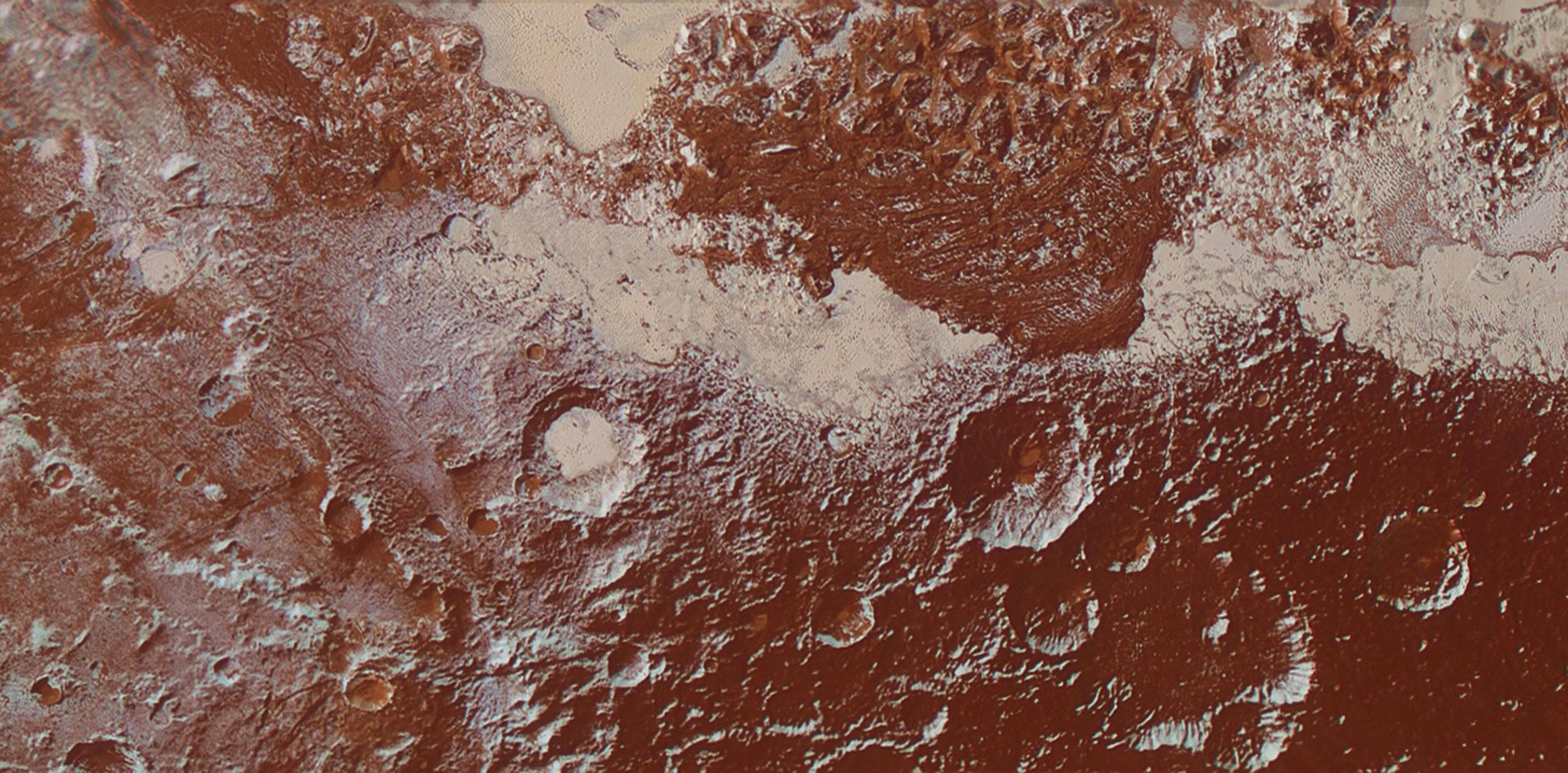 |
| Figure 13: The eastern edge of Cthulhu Regio, at the margins of Sputnik Planum, a region where tholins have coated the pre-existing relief with a dark reddish-brown layer. Credit: NASA/JHUAPL/SwRI |
Cryovolcanism?
If convective overturn is active in Sputnik Planum, one might expect to find signs of cryovolcanic activity too. Pluto’s density, size and surface composition are similar to those of Neptune’s largest satellite, Triton, which is believed to have been captured from the early Kuiper Belt when it was being perturbed by the migration of the outer planets. One of Voyager 2’s biggest surprises at Neptune was the discovery of ongoing cryovolcanic activity on Triton. New Horizons did not detect any such activity at Pluto. However, two broad-based mountains south-west of Norgay Montes, Wright Mons (shown in Figure 14) and Piccard Mons, could be of volcanic origin. At about 4km and 6km high respectively, both have summit depressions which could be indicative of cryovolcanic activity. And, lacking surface craters on their flanks, they are possibly quite recent features geologically speaking.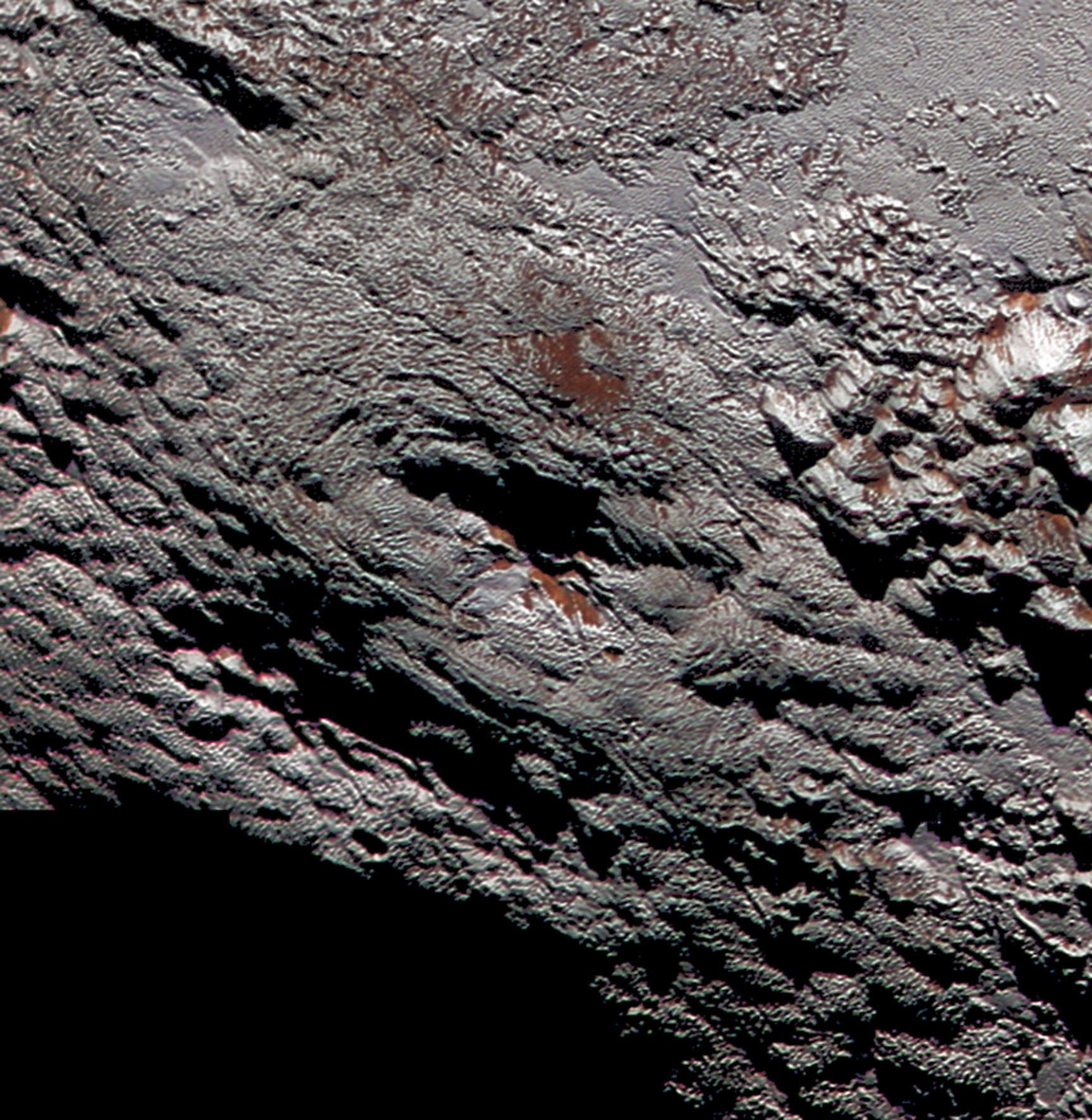 |
| Figure 14: This rounded mountain, named Wright Mons, has what appears to be a summit crater. It is one of two candidates for evidence of possible recent cryovolcanism seen on Pluto by New Horizons. Credit: NASA/JHUAPL/SwRI |
Dynamic atmosphere
We have spoken much above of apparent surface-atmosphere
interactions. Pluto’s atmosphere was a prime target for the New Horizons
mission team. It is composed of roughly 90% Nitrogen (N2), and 10% complex molecules such as methane (CH4),
carbon monoxide (CO), which are in equilibrium with their ices on the
planet’s surface. Its intricate and dynamic structure was revealed as
New Horizons looked back towards the Sun after flyby (Figures 15 and
16). As many as 20 individual thin (about 1.4km) layers of haze were
visible to over 200km everywhere around the planet.
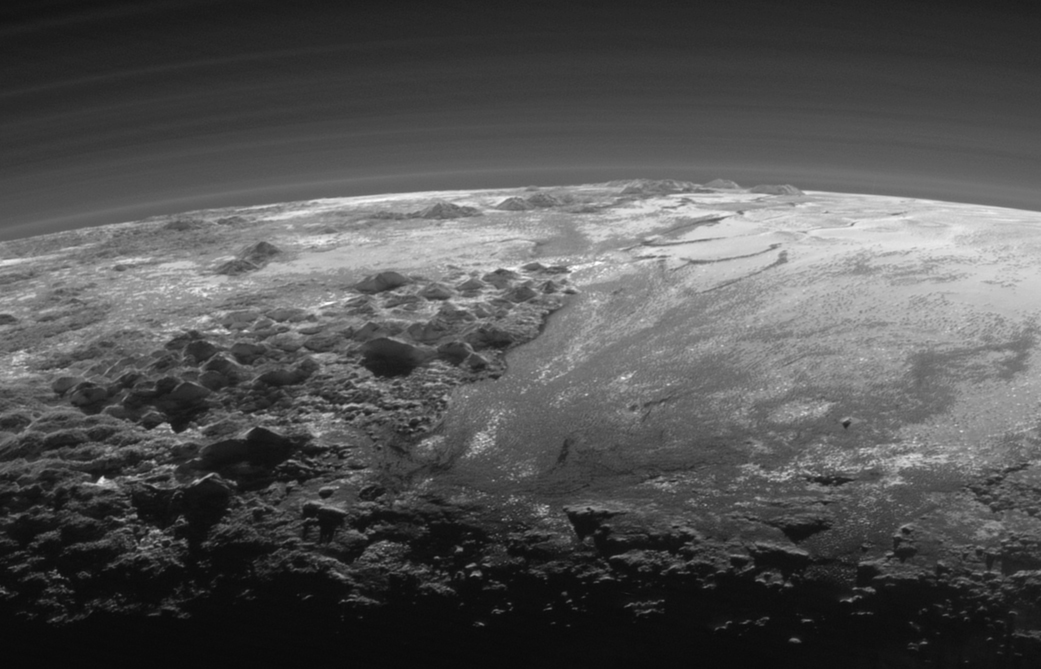 |
| Figure 15: View looking back through Pluto’s atmosphere towards the Sun, shortly after New Horizons’ closest approach, showing the delicate structure and multiple haze layers of Pluto’s atmosphere. To the left foreground and on the horizon are, respectively, the icy mountains of Norgay Montes and Hillary Montes, named for the first conquerors of Mount Everest. The smooth expanse of Sputnik Planum is to the right. Credit: NASA/JHUAPL/SwRI |
It has been suggested that Pluto and its atmosphere should experience
extreme seasonal changes over its eccentric orbit, which takes it from
30 AU at perihelion to 50 AU at aphelion. These are enhanced by the
dwarf planet’s extreme axial tilt of 120° to its orbit, which means that
at its solstices (when alternate poles are facing the Sun), a quarter
of its surface is in continuous daylight, while another quarter is in
continuous darkness. Changes in temperature may even lead to large
periodic increases in the density of this atmosphere, perhaps even to
the point where nitrogen could flow as a liquid at the surface. Some
intriguing flow features and channels were observed, and what appears to
be a frozen nitrogen lake (Figure 17) which might point to a time in
the past when this happened. However, it is still uncertain if and how
the extent and structure of Pluto’s atmosphere may change with
temperature.
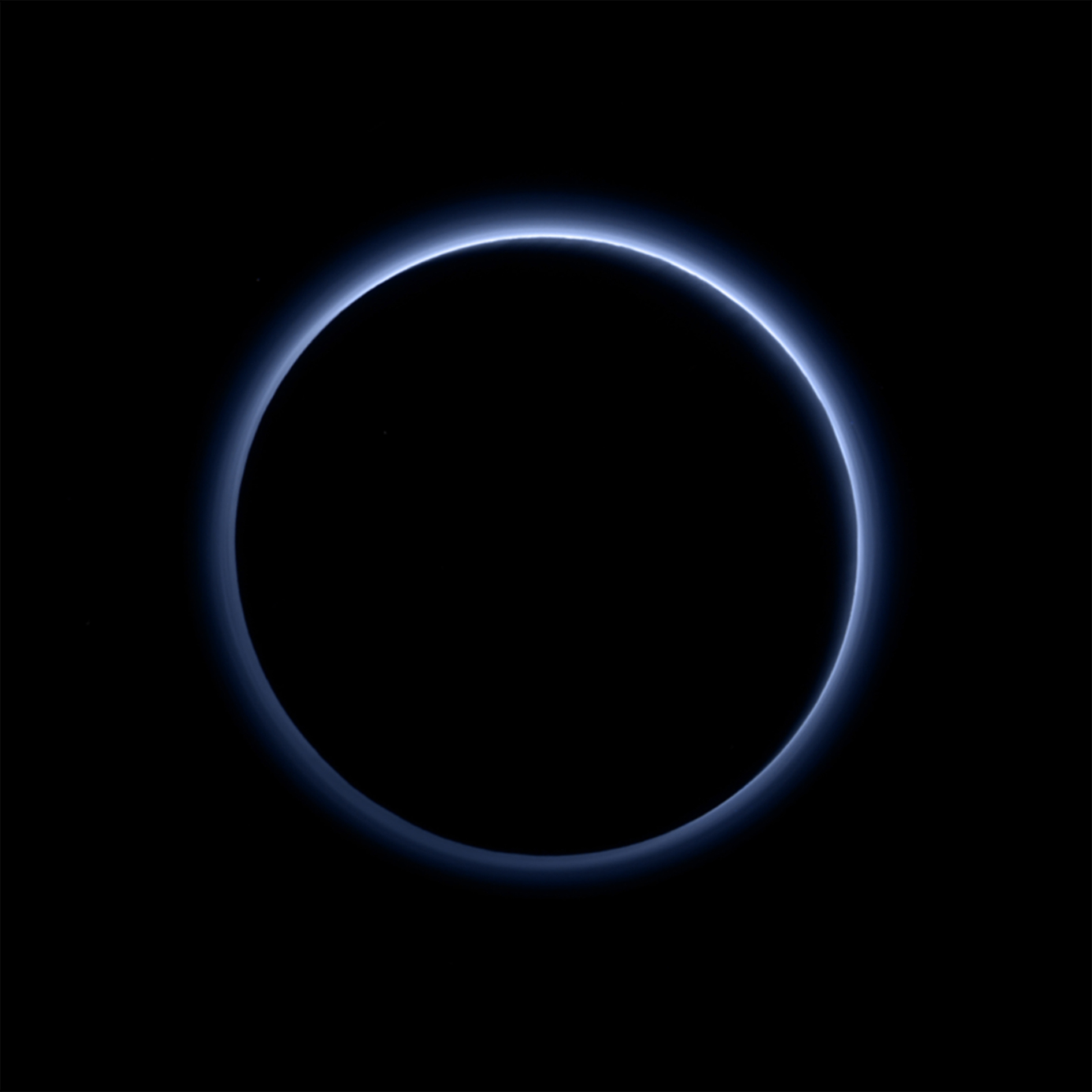 |
| Figure 16: Pluto’s ‘blue skies’, imaged by New Horizons’ Ralph/ Multispectral Visible Imaging Camera (MVIC). This blue colour results from the scattering of sunlight by very small particles, in this case probably tholins, soot-like particles created by complex chemical reactions of nitrogen and methane initiated by ultraviolet light from the Sun. Credit: NASA/JHUAPL/SwRI |
It was initially thought that, as Pluto moves further out from the
Sun in its orbit and temperatures fall, its atmosphere should gradually
‘collapse’, i.e. freeze onto the surface. However, data from New
Horizons and ground-based observations currently suggest that it may
remain gaseous, even at aphelion, although it wasn’t possible to fully
resolve the issue during the encounter. Leslie Young explains ‘We were
hoping to image the pole of Pluto currently in shadow by reflected
Charon-light, to try and analyse the ice cover there. However, the haze
layers in its atmosphere prevented us doing so, so we can’t answer this
question for now. We’ll need to continue Earth-based observations of
Pluto over the next few decades to see whether or not collapse does
occur.’
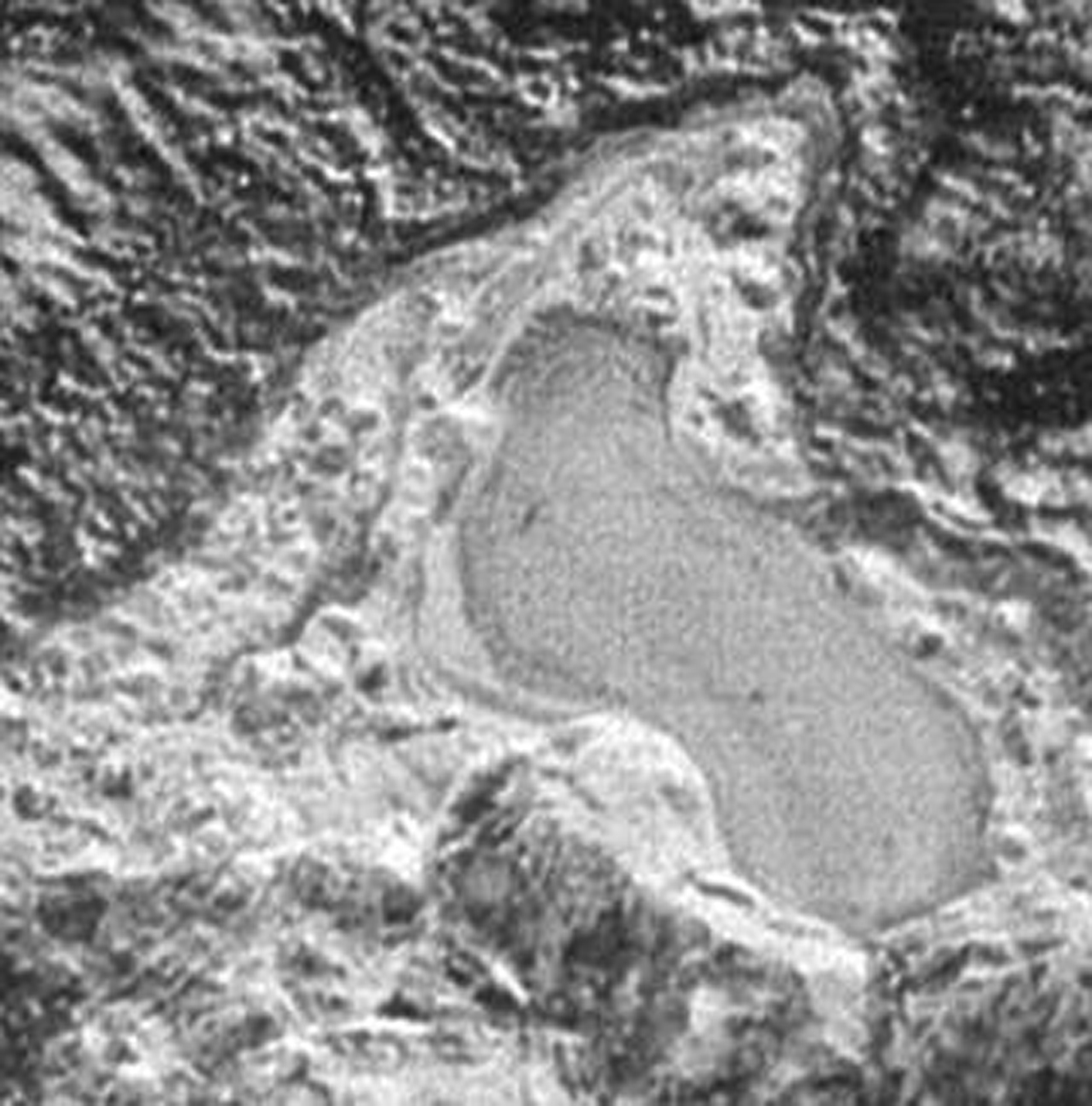 |
| Figure 17: This flat feature in the Al-Idrisi Montes to the west of Sputnik Planum looks very much like a frozen lake surface. Credit: NASA/JHUAPL/SwRI |
Charon – chasms, craters and much more
The Pluto-Charon system is unusual since the two are tidally locked
together, always having the same hemisphere facing each other. It is
suspected that Charon was created by a large collision, some 4 to 4.5
billion years ago, similar to that which is thought to have created the
Moon. The nearly circular orbits of Pluto’s smaller satellites suggest
that they were also formed in this collision, rather than being captured
Kuiper Belt objects.
Despite being only half the size of Pluto, Charon also exhibits a
surprising variety of landscapes and surface features, and shows
evidence of a varied geological history. Some of these are shown in
Figure 18 and described below. The northern polar region, Mordor Macula,
is reddish (A), indicating possible alteration of methane deposits by
solar radiation. Elsewhere, the northern hemisphere is ancient, rugged
and cratered (B). There are unusual localised ammonia (NH3) deposits
associated with a few bright craters (such as C). Ammonia ice hasn’t yet
been seen on Pluto, and its presence here is not fully explained as
yet, although it must be fairly recent, since it is eventually destroyed
by solar radiation and cosmic rays. It may a product of impact events
or even local cryovolcanism.
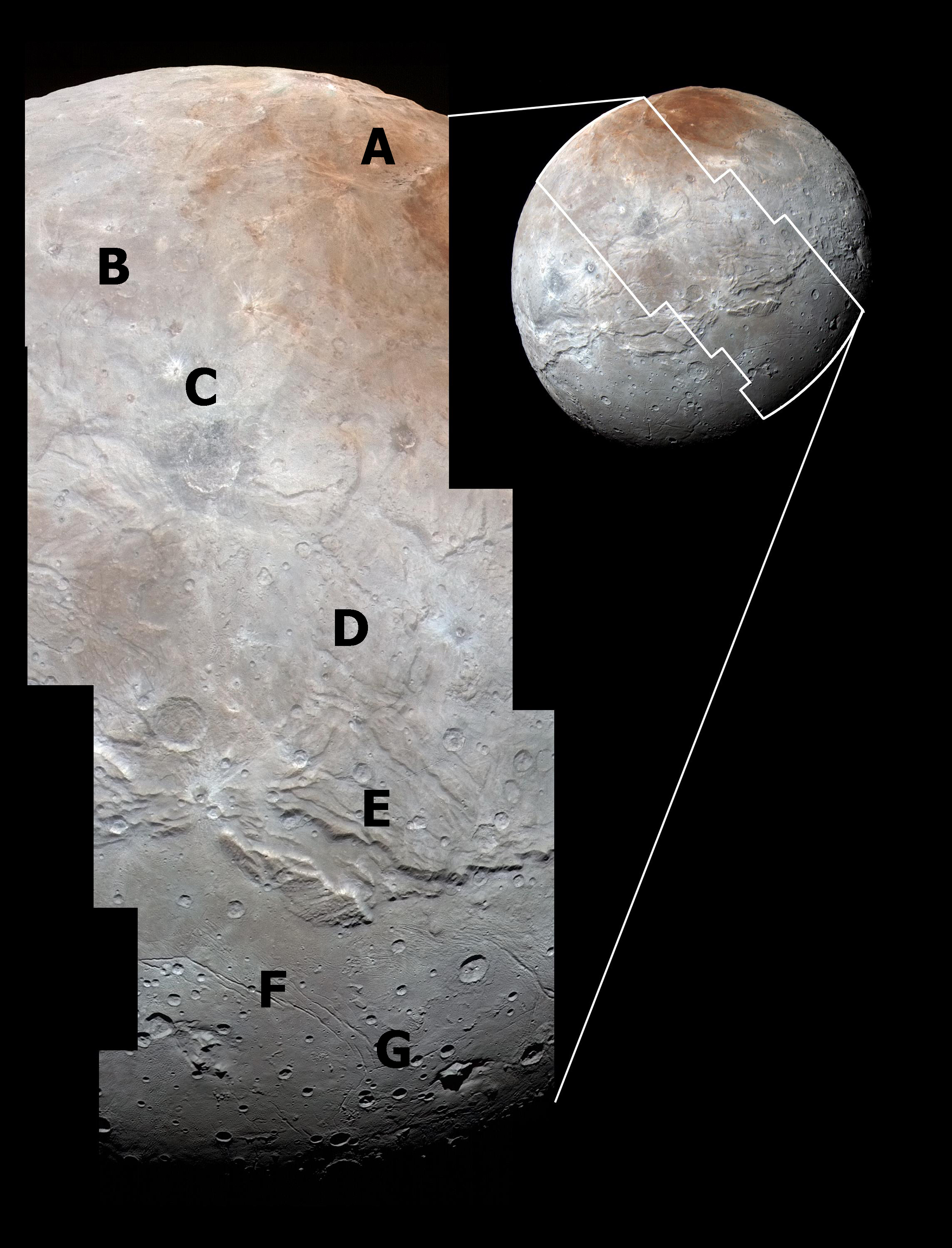 |
| Figure 18: An enhanced-colour image of Charon’s spectacular and intriguing landscapes. The letters refer to features described in this article. Credit: NASA/JHUAPL/SwRI |
The recent resurfacing on Pluto involving volatiles like nitrogen is
not seen on Charon, perhaps due to its lower gravity and subsequent loss
of such materials to space. Instead its surface is dominated by water
ice. There is evidence of ancient resurfacing, especially across its
smoother southern plains (F), but being smaller than Pluto, Charon’s
internal heat source was probably depleted early in its history.
Locally, surface ices may have flowed under pressure, such as at the
distinctive ‘mountain in a moat’ seen at G, where a water-ice mountain
has sunk into less viscous crustal material.
Perhaps the most distinctive and spectacular features on Charon are
its faults, often running in parallel series (D), and canyon systems,
which cut deeply across the hemisphere imaged by New Horizons. Serenity
Chasma (E) is one of the largest canyons seen in the solar system at
1,800 kilometres long, over 50km wide and 5 km deep. According to
mission scientists, they are indicative of the tectonic extension of
Charon’s crust. This would suggest that Charon once had an interior
ocean which froze early in its history, causing a global expansion of
about 1% or about 35km of shell thickening.
Pluto’s small moons
Pluto’s small moons are all brighter than Charon. Visual and
spectroscopic observations during the flyby indicate that they all have
water-rich surfaces and are probably of similar origin. Those which New
Horizons was able to image more clearly show old, cratered surfaces.
Their highly irregular shapes (Figure 19) suggest that they are the
result of merged bodies, probably composed of debris left over from the
collision which created the Pluto-Charon system.
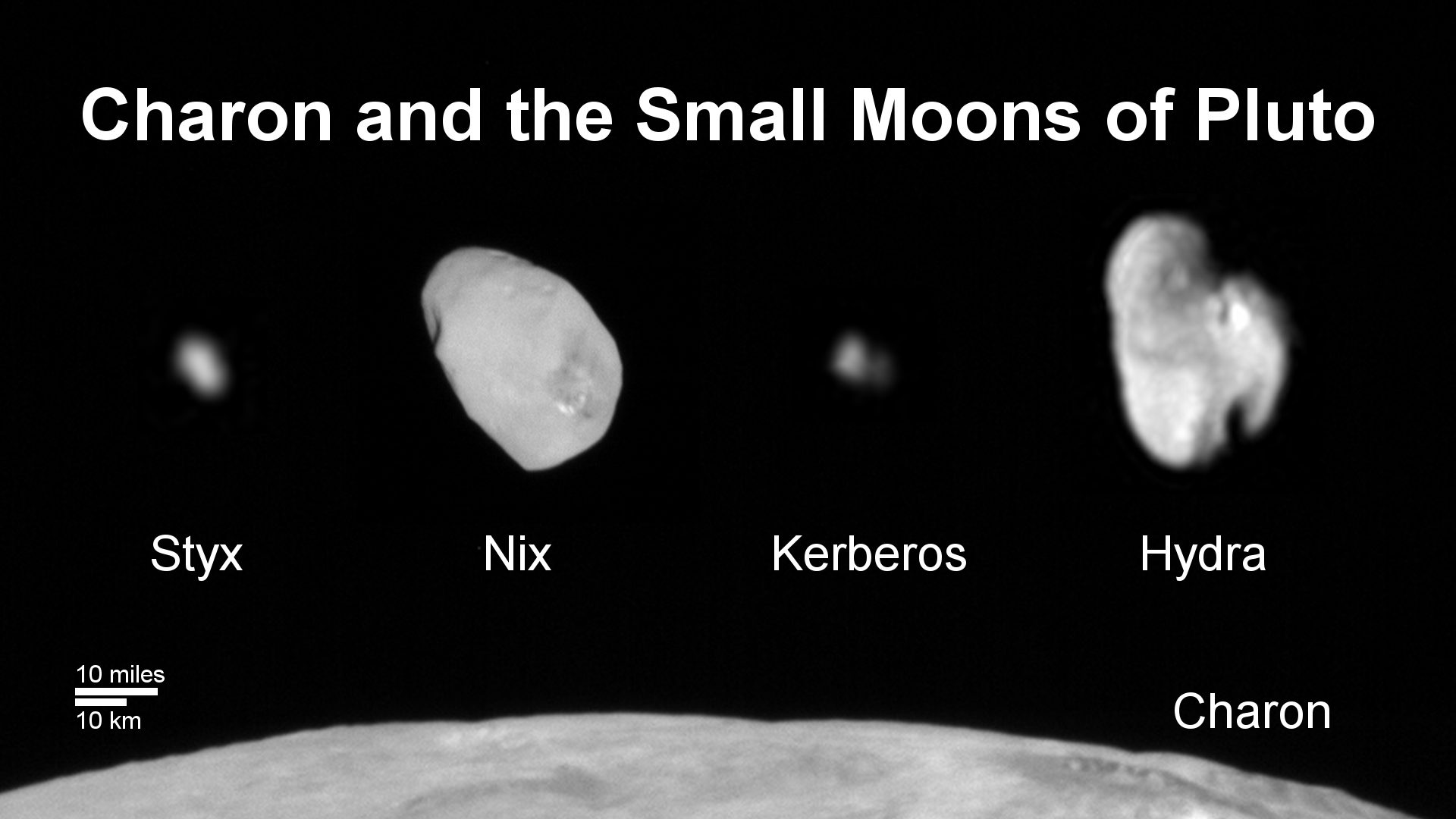 |
| Figure 19: The small moons of Pluto, shown to scale with Charon. Credit: NASA/JHUAPL/SwRI |
Interactions with the solar wind
As well as studying Pluto and its satellites, New Horizons was also
equipped to study the environment surrounding them and especially the
interaction of Pluto’s atmosphere with the solar wind. Even this far
from the Sun, it was thought that this continuous stream of charged
particles from the sun – mostly high energy electrons, protons and alpha
particles – would be eroding away the outer layers of Pluto’s
atmosphere. In the absence of a magnetic field to deflect the wind, this
is what occurs at Mars. Pluto’s bow-shock region (see Figure 20), where
the solar wind collides with the outer layers of the atmosphere, is,
like at Mars, quite abrupt – less than about seven Pluto radii, or
8,000km. However, atmospheric loss rates are low. The escape rate of
nitrogen is about 10,000 times lower than that predicted before the
encounter. This might be related to the colder than expected upper
atmosphere observed by New Horizons, and ‘has important implications for
the volatile recycling and long-term evolution of Pluto’s atmosphere.’
Like the Earth, Pluto has a long ion tail extending downwind beyond
for a distance of at least 400 Pluto radii (about half a million km). As
for the dust in the Pluto system which it was feared might be
encountered, only a very low density of particles – barely 1
micron-sized grain per km3 – was measured by the Student Dust Counter instrument.
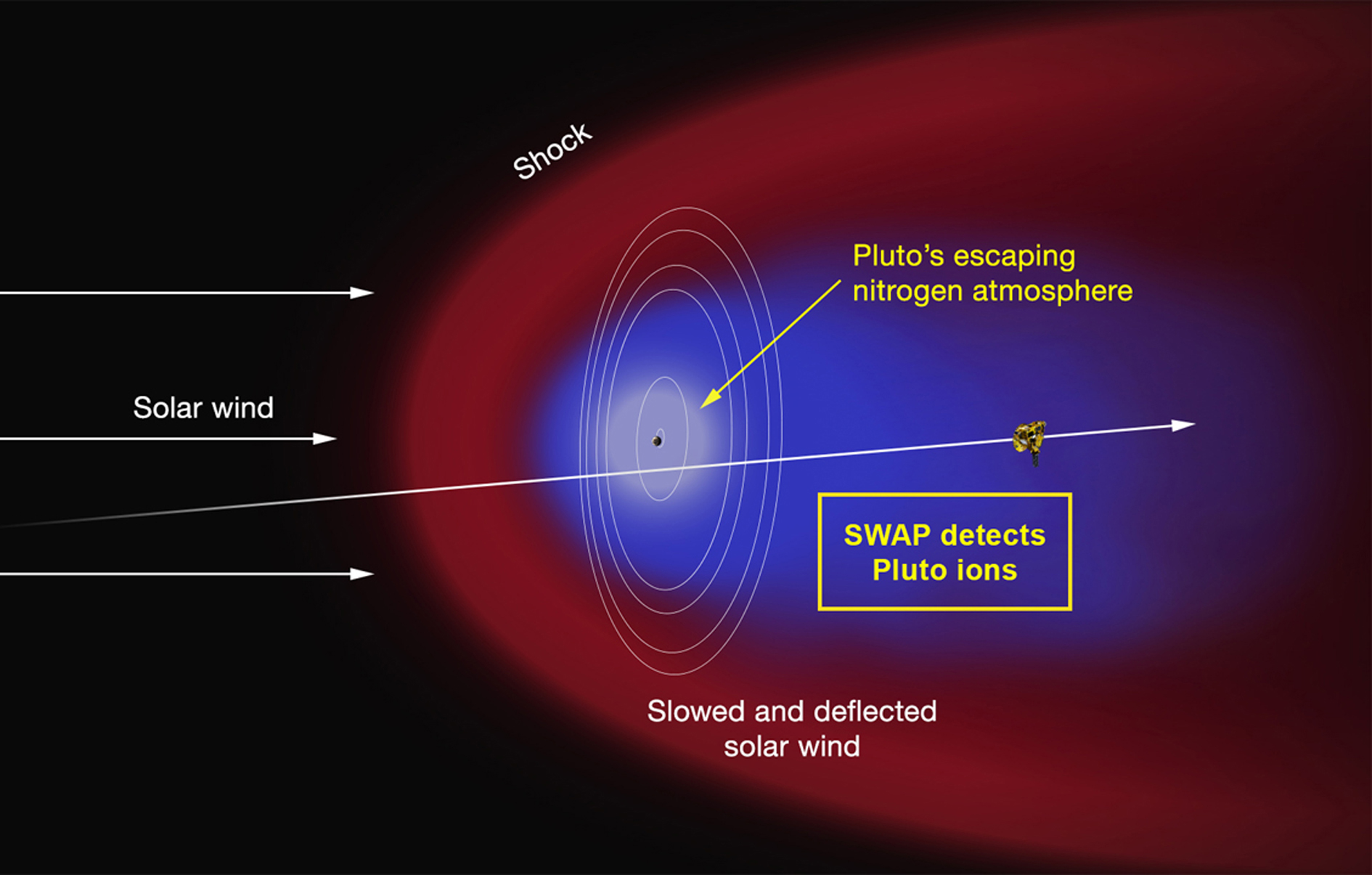 |
| Figure 20: New Horizons’ Solar Wind Around Pluto (SWAP) detector revealed interactions with the solar wind not dissimilar to those found at Venus and Mars. Credit: NASA/JHUAPL/SwRI |
Pluto in context – looking ahead
What we have learned from New Horizons’ encounter with Pluto, its
moons and its interactions with the solar wind are obviously important
in the context of the other members of the Kuiper Belt. Scientists now
have a better idea of what they might discover out in the far reaches of
the solar system, and that they can expect to find a much more active
population of worlds than previously imagined.
There were many who were upset at Pluto’s loss of planetary status
and so-called ‘relegation’ to the status of ‘dwarf planet’ in 2006.
However, ongoing discoveries confirming the population and extent of the
Kuiper Belt have given it a much more interesting position for those
studying the nature and evolution of the outer Solar System
Of ‘dwarf planet’ classification as it relates to the Kuiper belt,
Leslie Young says ‘I don’t think it’s a useful term. It’s not used much
at specialist level and I think it will die the death, especially as we
begin to look at the Kuiper Belt in more detail. We need a whole new way
of defining objects out here in the outer part of the solar system. We
have Pluto, with its great diversity of features. Then Haumea is just
the most astonishing creature! It’s water-bright and it’s the only KBO
where we’ve found that the siblings are all water-bright. Then Eris is
crazy-shiny! It has 96% geometric albedo. Yet, some of the other objects
are as dark as comets, so how does that happen?’
Will we find convective surface renewal on other large bodies at the
edge of the solar system, which may help to explain the high albedos
shown by some of these? So far, we have seen that Pluto, Charon and
Triton are all quite different. More surprises certainly await us as we
explore the denizens of the Kuiper belt.
The New Horizons team hopes that their extended mission will help
answer more questions about these. ‘Our future is in NASA’s hands,’ says
Leslie Young, ‘but we now have a rendez-vous with 2014 MU69 and on our
way we’re going to be looking at other Kuiper Belt Objects too from
distance. We’ll also be using our plasma detection instruments to study
the environment out here. Together with the two Voyagers we can try and
build up a three-dimensional picture of the outer solar system
environment using a series of one-dimensional shots. If possible we will
continue gathering data as long as we can, maybe over a couple more
decades.’
However long the mission is able to continue, it has already offered
us a glittering prize in Pluto and its family of moons. Speaking of her
involvement in the discovery of Pluto’s atmosphere back in 1988, Dr.
Young says that ‘when you help rewrite the textbooks, that’s an
addictive thing. You want to do it again and again.’ With New Horizons
en route for its next encounter, and as we continue to unlock the
secrets of the outer solar system, one senses that there is much more to
be written.
Glossary
VOLATILES – Elements or substances which condense
(and vaporize) at relatively low temperatures, such as nitrogen, methane
and water. Those which condense at high temperatures, like corundum (Al2O3) at 1758K or 1485°C, are refractory.
CRYOVOLCANISM – ‘Cool’ volcanic activity, where
‘cold slurries’ of volatiles such as water, ammonia or methane, erupt
and flow across a surface, in the same way that molten rock erupts and
flows as lava in warmer environments.
SOLID-STATE CONVECTION – Convection taking place in a solid, without the need for melting. For Pluto this would be within viscous, frozen volatiles.
TECTONIC – Related to the process of deformation within the crust of a planetary body and associated structural effects, such as faulting.
INSOLATION – Solar radiation reaching a planetary surface.
SUBLIMATION – Transition of a substance directly
from a solid to a gas without passing through the intermediate liquid
phase. This occurs with volatiles at Pluto’s surface as its atmospheric
pressure is too currently low for them to exist as liquids.
PLASMA – State of matter, created by adding energy
(e.g. solar) to a gas and driving electrons from atoms, leaving
electrically-charged particles or ions.
MAGNETOSPHERE – Region of space surrounding an astronomical object in which charged particles are controlled by that object’s magnetic field.
(GEOMETRIC) ALBEDO – The fraction of the solar
radiation falling on a body which is reflected by that body. Pluto’s
average albedo varies regionally from 0.49 to 0.66 – darker areas
reflect only 49% of incident light, whereas the brighter areas reflect
66%. For comparison, Earth’s average albedo is about 0.37 (37%) and our
Moon’s about 0.12 (12%).
ASTRONOMICAL UNIT (AU) – Mean distance between the Earth and the Sun, equal to 149.6 million km.
PERIHELION – Closest point to the Sun of any solar system body in orbit around it.
APHELION – The opposite, being the furthest point in its orbit from the Sun.
No comments:
Post a Comment